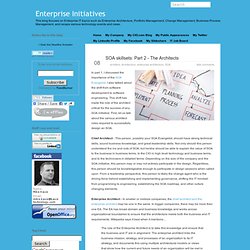

Soaconsortium. Stencil. » Small companies don’t have time for SOA. You hear it constantly from vendors -- the SMB market (small to medium-size businesses) is where it's at, baby.

This is especially the mantra we're hearing more and more in the service-oriented space. IBM talks SMB for new SOA deployments, and vendors such as Microsoft and JBoss are purportedly already mining the underserved small business space. How does a two-person IT operation adopt SOA? But, let's face it -- are small companies really equipped in terms of capacity and time to pursue SOA methodologies? On some level, SOA opens doors of opportunity for very small businesses to coalesce and offer their own as well as Other People's Services.
Joe's Shower Curtain Ring Company down the street may not be willing or able to pursue SOA as we know it. Just the other week, I spoke with the IS manager of a building construction parts company with about 500 employees and $30 million a year in revenues -- a very typical SMB. Such is the challenge when we talk about SOA moving into the SMB space. SOA skillsets: Part 2 - The Architects. In part 1, I discussed the importance of the SOA Evangelist.

I also talked about the shift from software development to software engineering. This shift has made the role of the architect critical for the success of any SOA initiative. First, let us talk about the various architect roles required to successfully design an SOA. Chief Architect - This person, possibly your SOA Evangelist, should have strong technical skills, sound business knowledge, and great leadership skills. Not only should this person understand the ins and outs of SOA, but he/she should be able to explain the value of SOA to the business in business terms, to the CIO in high level technology and business terms, and to the technicians in detailed terms. Enterprise Architect - In smaller or midsize companies, the chief architect and the enterprise architect may be one in the same.
The role of the Enterprise Architect is to take this knowledge and ensure that the business and IT are in alignment. 10 Must-Know Topics For Software Architects In 2009. In the last year or so, after quite a lull, the software architecture business has gotten rather exciting again. We're finally seeing major new topics emerging into the early mainstream that are potential game-changers, while at the same time a few innovations that have been hovering in the margins of the industry are starting to break out in a big way. The big changes: The hegemony of traditional 3 and 4-tier application models , heavyweight run-time platforms, and classical service-oriented architecture that has dominated for about a decade is now literally being torn asunder by a raft of new approaches for designing and architecting applications. These might sound like incautious words but major changes are in the air and architects are reaching out for new solutions as they encounter novel new challenges in the field.
Let's also not forget about Web 2.0 approaches and design patterns which are becoming ever more established in online applications and enterprise architecture both.